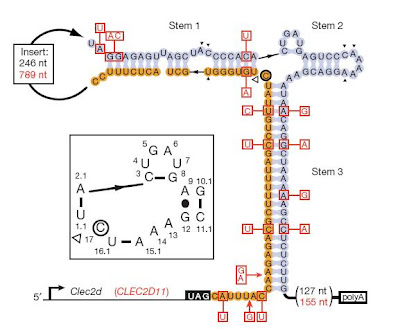Source: Daran-Lapujade, P., Jansen, M.L.A., Daran, J., van Gulik, W., de Winde, J.H., and Pronk, J.T. Role of transcriptional regulation in controlling fluxes in central carbon metabolism of Saccharomyces cerevisiae. 2004. Journal of Biological Chemistry, 279(10): 9125-38
The authors grew yeast in chemostats under carbon-limitation on one of four carbon sources: glucose, maltose, acetate, and ethanol. They used flux balance analysis to come up with metabolic fluxes through key proteins and also measured transcript abundances across the genome for all four conditions. They found that there was not a great difference found (as compared to Kresnowati et al) except in 117 transcripts, between fermentable sugars and C2-carbon sources, though fluxes differed significantly at many steps in carbon metabolism. The difference between maltose and glucose was limited mainly to maltose transporters, both in flux and transcript abundance. Similarly, there was not a great difference between acetate and ethanol. Looking at the transcript abundance, the authors saw that the 117 transcript profiles clustered into six clusters relating to difference between glucose/maltose and acetate/ethanol, as well as within the carbon sources (ie, between glucose and maltose), the expected genes were in the expected clusters. Looking at the MIPS classification of the genes, 40% are still unknown, while 29% relate to carbon metabolism. The authors then looked at the upstream sequences for clustered genes, discovering conserved sequences for transcription factors. Of these transcription factors a few were predicted while unknown factors seem to play a role in more. Noting the discrepancy between changes in flux and changes in transcript abundance, even the magnitude changes, the authors suggest that most carbon-metabolism is altered via post-transcriptional regulation, and that transcript regulation is only used for rate-limiting steps in pathways. Finally, the authors hypothesize reasons their changed transcript dataset is so small compared to others who have looked at carbon source change and suggest it is due to the chemostat. The authors strongly feel the chemostat keeps a more constant environment, allowing changes to single perturbations, as opposed to stress, growth, and overabundance that is seen in batch.
Other notes:
-180 total transcripts change in response to carbon source
=33 between glucose and maltose
=16 between ethanol and acetate
=117 between sugars and C2-compounds
-complete data set found at www.bt.tudelft.nl/carbon-source
-maltose uptake requires energy-dependent proton-symport mechanism as opposed to glucose’s simple diffusion
-biomass yields for C2 lower due, respiration rates higher due to lower ATP yield
-higher fluxes in TCA, glyoxylate cycle, gluconeogenesis for C2
-lower fluxes in glycolysis, oxidative-PPP, NADP-dependent acetaldehyde and/or isocitrate dehydrogenases for C2
-79 upregulated, 38 downregulated in cultures limited by C2
=79 : 21 carbon metabolism, 7 for TCA, 5 acetyl-CoA metabolism and trafficking, 3 transcriptional regulation, 8 for transport, 7 for nitrogen metabolism and transport (SAM3), only 1 in respiration
=38 : 20 no clear role, 10 carbon metabolism, 4 PPP, 3 transport, 1 signaling
-previous studies on diauxic shift 400 transcripts shown to change 2-fold, 600 in glucose vs ethanol in batch
=225 genes are transcriptionally regulated by glucose, but not in glucose-limited chemostat with low glucose concentrations
=acetate as a byproduct for glucose batch, alters pH gradient, causes stress response
-in chemostat glucose is too low to encourage ethanol/acetate production
=growth rate decreases in batch, held steady in chemostat
-magnitude of changes does not match up, requires more than transcription regulation
=glycolysis and pyruvate showed no correlation
=“during carbon-limited cultivation, fluxes through these central metabolic pathways in S. cerevisiae are not primarily controlled at the transcriptional level”
=DNA microarrays “have limited value as indicators for in vivo activity for proteins”

Metabolites at right, transcript at left; significant decreases between carbon sources underlined, increases highlighted. Many more metabolites differ significantly than their corresponding enzyme's transcript, and magnitudes rarely match!
This has been a pet peeve of mine for a while: the multitude of studies that do some experiment, slap a microarray around and claim: "Aha! Look how many genes change! THIS is
quite important!" Research should mature to look deeper at phenotypes: proteomics and metabolomics come to mind. Plus, this opens up a huge field of importance for genomicists: post-transcriptional regulation.
 How is this helpful?
How is this helpful?
















